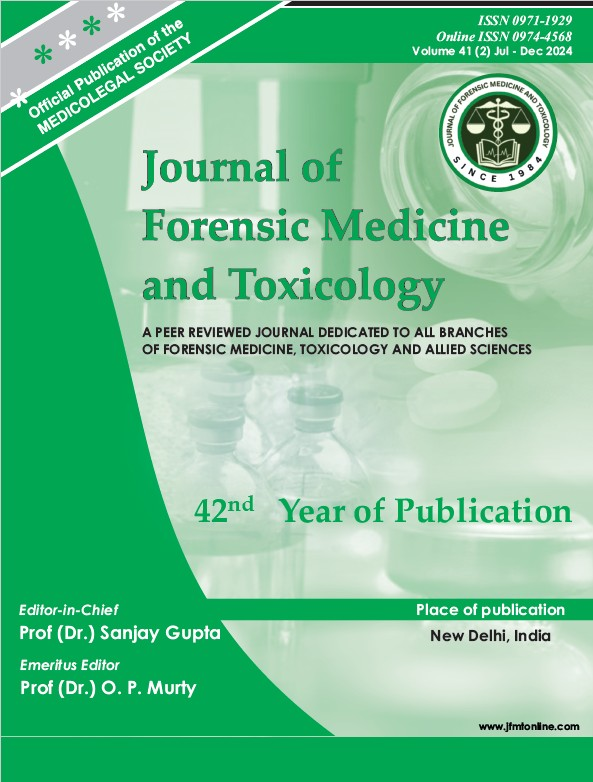UTILIZATION OF MEDULLARY INDEX FOR ORIGINAL DOG BREED IDENTIFICATION IN FORENSIC PERSPECTIVE
Keywords:
Hair, Evidence, Dogs, Breeds, Medullary IndexAbstract
Hair plays an important role in criminal investigation. Due to their close relationship with humans, dogs’ hairs are easily exchanged as they are likely to shed with a slight touch. Different domestic animal species are ranked according to their medullary index, which aids forensic scientists in identifying and comparing various animal hair species. If the hair is from an animal, the forensic investigator may be able to determine which species it came from; the hair could be from a pet or a wild animal; the clues reveal which part of the body the hair came from, if it is human hair; the person’s race, gender, age, and whether the hair was shed naturally or pulled from someone’s body part. The research determines the variations in microscopic characteristics which helps in individualization and differentiation of different breeds. The methodology consisted of sample collections taken from 50 healthy dogs. These hairs are of different breeds of dogs that possesses variations in Fluorescent Microscope with Bright field Digital Microphotography Leica-1000. The result concludes the morphological characteristics like hair colour, hair type, medullary index pattern and micrometric values like medullary index, cuticular index and average hair length of the dog’s breeds. The result also includes the rare finding that is the original Labrador dogs breed shows split ends. -The medullary index gives the exact identification of the
Downloads
References
CADAR, M.E.J.B.U.A.S. and Biotechnologies, SEM study of hair cuticle in some Canidae breeds. 2015. 72(2).
Müntener, T., et al., The canine hair cycle–a guide for the assessment of morphological and immunohistochemical criteria. 2011. 22(5): p. 383-395.
Airlie, M., J. Robertson, and E.J.F.S.I. Brooks, Forensic hair analysis–Worldwide survey results. 2021. 327: p. 110966.
Nabo¿ny, M.J.W.Z., Charakterystyka organizacji korzeni w³osowych w skórze zwierz¹t futerkowych z uwzglêdnieniem gêstoœci okrywy w³osowej. 2015. 2(53).
De Marinis, A.M. and A.J.W.b. Asprea, Hair identification key of wild and domestic ungulates from southern Europe. 2006. 12(3): p. 305-320.
Suzanski, T.W.J.C.S.o.F.S.J., Dog hair comparison: A preliminary study. 1988. 21(1-2): p. 19-28.
Vázquez, C., et al., Domestic dog hair samples as biomarkers of arsenic contamination. 2013. 42(4): p. 220-223.
Saferstein, R., Criminalistics: An introduction to forensic science. 2007: Pearson Prentice Hall Upper Saddle River, NJ.
Barksdale, L., J.J.J.o.F.S. Humrich, and C. Investigation, Random distribution of cat/dog hair in motor vehicles. 2017. 5.
Dehury, S., et al., Light and scanning electron microscopy analysis of hair samples of some wild animals for individual identification. 2019.
Negi, P., et al.,Comparison of different Animal Species Hairs with respect to their Medullary Index for the Individual Identification and comparison from the Animals of local Village of Palam Vihar, Gurugram, Haryana. 2017. 10.
Vaishnav, L., et al., A study on hair analysis of different Canidae breeds. 2021. 3: p. 100169.
Boehme, A., et al., The persistence of animal hairs in a forensic context. 2009. 41(2): p. 99-112.
Das, S., et al., Light and scanning electron microscopy aided with elementary analysis in characterization and identification of hair of Assam hill goat. 2018. 6: p. 1141-1148.
Lungu, A., et al., Image analysis of animal hair: morphological features useful in forensic veterinary medicine. 2007. 40: p. 439-446.
Lanning, K.A., et al., Scientific working group on materials analysis position on hair evidence. 2009. 54(5): p. 1198-1202.
Sahajpal, V., et al., Microscopic hair characteristics of a few bovid species listed under Schedule-I of Wildlife (Protection) Act 1972 of India. 2009. 189(1- 3): p. 34-45.
Knecht, L.J.W.f.m. and applications, The use of hair morphology in the identification of mammals. 2012. 8: p. 129-43.
Karczmarczyk, S. and M. Gryziñska, Identification value of dog (Canis lupus familiaris) and cat (Felis catus) hair based on selected features of morphology in the context of forensic examinations.
Wandhare, P.P. and M.S.J.I. Bhosale, Trichology: a science of hair examination in identification of dog breeds. 2017. 3(6): p. 61-6.
Kshirsagar, S., et al., Comparative study of human and animal hair in relation with diameter and medullary index. 2009. 2(3): p. 105-108.




